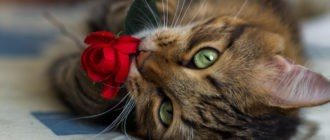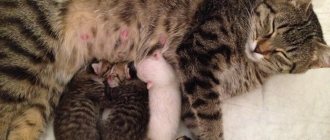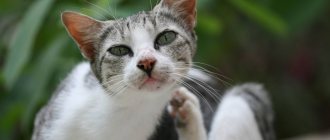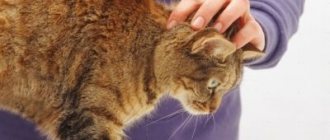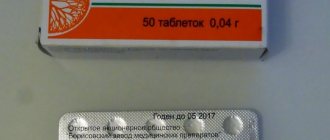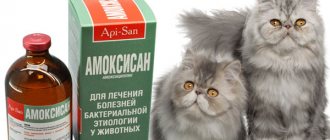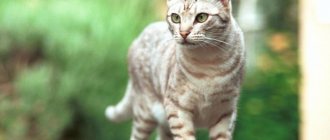Every spring, cats and female cats go into heat, which causes a lot of inconvenience to their owners. Animals become uncontrollable, aggressive, and lose their appetite. The only way out is to let them satisfy their need. But what to do if the birth of kittens is not part of the owner’s plans? Gestrenol, drops for cats, the instructions for which allow you to find out how to prevent unwanted pregnancy and control sexual heat, can help. The drug contains only natural hormonal components: ethinyl estadiol and propionate mepregenol, which reduce the production of its own hormones in the cat’s body and prevents ovulation.
Composition and release form of the drug
Gestrenol drops are produced in Russia, Moscow. The drug is a greenish-yellow oily liquid with a weak specific odor and taste. Gestrenol is available in plastic dropper bottles with a volume of 1, 1.5, 2, 3 or 5 ml and in tablet form. Each bottle is packed in cardboard boxes with instructions.
Gestrenol is a hormonal drug that regulates estrus in cats.
The main active ingredients of the drug:
- mepregenol propionate (1.5 mg);
- ethinyl estradiol (0.015 mg).
Various flavoring additives, sugar, soybean oil and starch are used as additional components, and to make cats more willing to take the medicine, catnip is added to it.
Price information and list of analogues
You can buy the medicine at any veterinary pharmacy. The cost of a package containing a dozen tablets is about 52 rubles, and a bottle of drops is about 95 rubles.
There are other tablets that are analogues of Gestrenol, which are given to a cat during heat.
Among the analogue drugs of Gestrenol, several popular feline contraceptives can be distinguished.
Table: analogue drugs
| Name | Compound | List of indications | List of contraindications | Price |
| Stop intimate | Active ingredient: megestrol acetate. Auxiliary ingredients:
|
|
|
|
| Sex barrier | 1 ml of medicine contains:
|
|
Medicines made for females are not suitable for males |
|
| Contrasex | Main active components:
|
|
|
|
| Libidomin | Active ingredient: mepregenol acetate | For cats:
For cats:
|
|
|
Photo gallery: medicines-analogues of Gestrenol
Contrasex is a drug containing synthetic hormones
Libidomin contains an active substance that is an analogue of progesterone
The sex barrier is available separately for males and females
A popular feline contraceptive is Stop-intim
Features of the drug
Gestrenol is one of the best contraceptives for cats. The active ingredients of the drug are synthetic hormones that inhibit ovarian function. In the process of taking it, the acidity of the vagina increases in cats, which prevents conception during mating, the estrus period is interrupted or delayed, and the cats stop producing sperm, sexual desire disappears and aggression decreases.
Important. Under no circumstances should cats be given medicine intended for cats, and vice versa.
Gestrenol is absolutely safe for animals, does not accumulate in cell tissues, and does not affect the nervous and reproductive systems of the body. The ability to fertilize and complete restoration of reproductive function appears 2-3 months after the end of taking the drug.
How to give the drug to your pet
The exact dosage and duration of the course of use of the drug can only be determined by a veterinarian.
General recommendations for the use of contraception:
- drops are dripped onto the pet’s nose, tongue or food;
- the tablet is placed on the root of the tongue or, crushed, mixed with drink and food;
- 2–3 months after the end of the therapeutic course, the reproductive function of the cat’s body is restored.
Table: order of application of drops
| When is the remedy prescribed? | Pet weight in kg | Dosage, number of drops | Reception frequency | When to start taking | Features of application |
| Inhibition of sexual activity processes | up to 5 | 4 | Once for 3–5 days | At the first sign of heat |
|
| 6–10 | 5–8 | ||||
| Delayed heat | Regardless of mass | 4 | Once every 7 days | Between heats |
|
| Prevention of pregnancy (relevant only for cats) | 8 | Twice with an interval of 24 hours | No later than 24 hours after mating | When taking the drug late, the therapeutic effect decreases |
Gestrenol drops are dripped onto the cat’s nose one at a time, she licks them off, and the product enters the body.
Table: order of use of birth control pills
| When to use | Single dosage | Frequency of application | When to start taking | Features of application |
| Inhibition of sexual activity processes | 1–2 tablets. For the first time, young individuals are prescribed 2 tablets at a time. | Once for 4–5 days | At the first sign of heat |
|
| Prevention of pregnancy (relevant only for cats) | 1 tablet | 2 tablets 24 hours apart | Immediately after mating. No more than 48 hours should pass. | The use of the drug is not advisable if two days have passed since sexual intercourse |
| Maintain a calming effect | 1 tablet | 2–3 days monthly | During the period of sexual rest | None |
Video: how to give a cat a pill
Pharmacological properties
Gestrenol is a hormonal contraceptive drug for cats. The principle of operation, which is based on the fact that mepregenol propionate (gestagen) blocks the production of follicle-stimulating and luteinizing hormones in the hypothalamus. And they, in turn, are responsible for the formation of follicles in the ovaries and ovulation.
The drug Gestrenol is safe for animals.
Ethinyl estradiol changes the composition of the cat's uterine mucus, making it viscous and thick, which prevents sperm from penetrating into the uterine cavity. And if fertilization does occur, then the fertilized egg cannot penetrate the endometrium and an involuntary termination of pregnancy occurs. In cats, the active ingredients of the drug reduce sperm activity.
Gestrenol drops are absolutely safe for the health of the animal, and the active components are completely eliminated from the body along with urine within two days.
Operating principle
"Gestrenol" refers to hormonal agents intended to regulate sexual desire in cats. The principle of operation occurs according to the following scheme:
- The hypothalamus is responsible for the production of sex hormones (follicle-stimulating and luteinizing).
- Mepregenol propionate, which is part of the drug, completely blocks them.
- The follicles in the ovaries do not mature and ovulation does not occur.
- Ethinyl estradiol affects the composition of mucus in the cat's genitals. It becomes thick and viscous, which makes it difficult for sperm to penetrate into the uterine cavity.
- If fertilization occurs, the pregnancy is terminated because the fertilized egg cannot attach itself to the loose endometrium.
The drug has a similar effect on cats. Sperm production decreases, sexual desire disappears, and the pet's behavior returns to normal.
Indications for use
Gestrenol affects not only the physiological processes in the cat’s body, but also the animal’s behavior. Drops allow you to adjust the period of estrus (interrupt or delay) and reduce the production of sex hormones.
Purpose of the drug:
- decreased libido;
- termination of an unplanned pregnancy;
- correction of the appearance of estrus;
- reduction of aggressiveness and agitation.
Before using the drug, the instructions for use should be carefully studied to avoid unpleasant consequences in the future.
Instructions for use and dosage for cats
Before use, the bottle with the drug must be shaken well. Drops can be administered directly into the animal's mouth, added to food, or dripped onto the nose. So, how many times a day should I spray the drug? Gestrenol is most effective at the very beginning of the estrus period.
The drug is given to cats in the dosage specified in the instructions.
To interrupt it, it is enough to give 4 drops of the drug once a day to cats weighing less than 5 kg. For animals weighing 6-10 kg, the single daily dose is increased to 5-8 drops. The course of treatment is at least 3-5 days. It is impossible to interrupt treatment and then resume it again. Even after sexual heat has passed, the medicine is given for another day.
If an unplanned, accidental mating occurs, then, as protection against pregnancy, the cat is given 8 drops of the drug at a time. In this case, the dosage is standard, regardless of weight and age. A day later, another 8 drops of Gestrenol are given.
To delay the onset of the next estrus, you can give the drug as a prophylaxis during sexual rest. The dosage will be 4 drops once a week. But you shouldn’t interrupt estrus more than twice a year. This may harm the animal.
Important. To prevent pregnancy successfully, the drug must be given to the animal within 24 hours after mating.
Contraindications and side effects
Like any medicine (even the safest), Gestrenol drops also have a number of contraindications. The drug should not be given to young, immature kittens or cats during pregnancy and lactation. Gestrenol is contraindicated in animals suffering from diabetes, genitourinary diseases, and cancer. Sometimes a pet may develop individual intolerance to certain components of the drug. In this case, the veterinarian may advise changing the contraceptive.
If you greatly exceed the required dosage, the following side effects may occur:
- changes in behavior;
- vomit;
- increased appetite;
- allergic dermatitis;
- profuse salivation.
If the instructions are strictly followed, Gestrenol does not cause side effects or addiction. It is compatible with most medications.
- INTRODUCTION
- PUBERTY
- SEASONAL CHARACTER OF THE ESTRAL CYCLE
- MATING AND INDUCED OVULATION
- HORMONAL SUPPORT OF OVULATION, FALSE PREGNANCY AND PREGNANCY
- ENDOCRINE PROCESSES
- VAGINAL CYTOLOGY
- LITERATURE
CHAPTER 2
Features of physiology and endocrinology of cats
John Verstegen
INTRODUCTION
Over the past decade, an impressive body of evidence has been developed regarding the relationship between behavioral, ovarian and endocrine changes occurring in cats during anestrus, estrus and the luteal phase after sterile or fertile mating, pregnancy and the puerperium. However, there are still gaps and contradictions in knowledge about reproductive physiology and endocrinology that require further research.
The estrous cycle in cats is seasonal (although there are exceptions) and is in many ways similar to the cycle of mammals such as rabbits, minks and ferrets, especially with regard to the induction of ovulation.
PUBERTY
The average age of puberty varies among domestic cats. As a rule, the first estrus begins when the animal's weight reaches 2.3–2.5 kg. Normally, a female can reach sexual maturity no earlier than 4 months and no later than 18 months, but in most cases the first signs of sexual activity appear at 6–9 months.
To some extent, the age of puberty is determined by heredity, with some breeds demonstrating early or, conversely, relatively late maturation. The most “precocious” are the short-haired breeds (Siamese, Burmese), the animals reach maturity with less weight than cats of long-haired breeds (Persian), in which the first heat can begin at the age of 18 months. However, as far as can be judged, the main factor determining the timing of puberty and the establishment of the cycle is the duration and intensity of daylight hours or artificial lighting (for animals kept indoors).
Reaching sexual maturity depends on the time of year and usually occurs at a time when daylight hours increase.
Females that enter puberty in late summer, with long daylight hours, exhibit behavioral estrus at an earlier age than those that reach maturity in the fall or winter—in the latter case, estrus is not observed until the following spring. Fig.
2.1. Changes in the concentration of progesterone in blood plasma during physiological and false pregnancy. Reproduced from the book. Lane and Cooper "Veterinary Nursing", (1994) with permission from Butterworth Heinemann
SEASONAL CHARACTER OF THE ESTRAL CYCLE
In the absence of pregnancy or false pregnancy, estrus in cats resumes every 2-3 weeks in the spring, summer and fall.
When kept in a room with artificial lighting, especially if the light is on at night, the periodicity of the cycle can appear regardless of the time of year; in such cases, estrus in cats is observed in winter. The influence of lighting on the reproductive cycle occurs through the pineal gland and the hormone melatonin it produces. The mechanism of action appears to be similar to that observed in mares. Behavioral cycle
From a behavioral point of view, a cat's cycle can be roughly divided into the period of heat and the period of absence.
Proestrus and estrus
The estrus period is divided into proestrus and estrus. Behavioral manifestations of proestrus and estrus are observed within 3–10 days. The transition from proestrus to estrus in cats, unlike dogs, is not pronounced, since, with the exception of behavioral ones, both phases are not characterized by noticeable external manifestations. Estrus is the period when a cat experiences sexual arousal and allows a male to approach her. The first days of estrus (from 1 to 4 days), during which the female demonstrates behavioral estrus, but does not allow the male to approach her, are called proestrus. It is difficult to determine the proestrus phase using clinical methods, since some females allow the male to approach them simultaneously with the onset of behavioral estrus, i.e., bypassing the preparatory period of proestrus. The development of follicles during proestrus begins against the background of a reduced concentration of estradiol, which is insufficient to ensure maximum manifestations of behavioral estrus.
The beginning of estrus is determined by the fact that the cat allows the male to approach her, and its completion is judged by the end of such behavioral manifestations. The period of estrus is characterized by the maximum level of estrogen produced by the follicles.
During the period of heat, the cat rubs against people and objects, rolls around, and often shows extreme friendliness. A characteristic feature is drawn-out calling cries. When stroking, especially on the back, the cat takes a characteristic pose - arches its lower back, raises its croup, moves its tail to the side and moves its paws. Males show interest in the female, who, having entered the period of estrus, can run away from home to mate. During mating, the cat makes loud cries and forcefully, and sometimes aggressively, tries to free itself from the male holding her by the withers. After mating, sexual arousal subsides for a while; however, the first one is soon followed by new, multiple copulations, usually observed throughout estrus. There is an assumption that matings shorten the period of estrus, although it is quite difficult to verify the validity of this statement under controlled breeding conditions.
Examination of the external genitalia does not reveal changes that clearly indicate the onset of estrus.
In some cases, there is slight redness or swelling of the vulva, but there is no discharge. Sometimes the genital fissure, invisible during anestrus, becomes visible. Interestrus and anestrus
In the absence of mating and/or spontaneous ovulation, estrus returns every 10–14 days throughout the reproductive season. The interval between two periods of intense sexual activity during which
The animal does not exhibit specific physiological and behavioral signs and is called interestrus. Interestrus is characterized by relative rest of the ovaries and uterus, associated with preparation for the next cycle of follicular development and, accordingly, the next estrus. During interestrus, estrogen concentrations decrease to basal levels.
However, in some animals the cycles of follicular development follow one another without intervals. In this case, estrogen concentrations do not decrease and the cat may exhibit constant estrus. This phenomenon is often mistakenly called nymphomania or prolonged estrus.
During the period of anestrus, which is characterized by complete rest of the ovaries, in contrast to interestrus, there is a prolonged absence of both sexual activity and signs of reproductive behavior. The onset of anestrus coincides with a reduction in daylight hours or artificial lighting to 4–6 hours a day.
As a rule, in animals of the northern hemisphere, anestrus is observed in late autumn or early winter, but it may not occur if the cat lives in conditions of constant daylight hours.
MATING AND INDUCED OVULATION
Speaking about the characteristics of cat reproduction, as a rule, they note the induced nature of ovulation, i.e. ovulation is observed as a reaction to coitus (natural - during the process of copulation, or artificial - as a result of vaginal manipulation), although in some cases it can occur spontaneously. Vaginal stimulation during copulation causes stimulation of nerve fibers, which is transmitted to the hypothalamus and serves as a trigger for the release of GnRH. The release of GnRH in turn stimulates the release of luteinizing hormone LH. Likewise, administration of exogenous gonadotropins or GnRH causes multiple eggs to ovulate within 24 to 48 hours of administration. The rate of ovulation is obviously directly related to the amplitude of the LH peak, which depends on the number and intensity of matings. The interval between vaginal stimulation and ovulation is inversely proportional to the number of matings and endocrine status during copulation. With matings that take place in the middle of estrus, ovulation occurs earlier than with matings that take place at the beginning of estrus. But in any case, ovulation occurs no earlier than 24 and no later than 52 hours after the induced LH surge. 24–48 hours after ovulation, estrus stops. However, in some cases, the LH surge occurs spontaneously - in the absence of mating or vaginal stimulation, but also causes ovulation. A characteristic increase in progesterone concentration observed after ovulation was recorded in cats that did not participate in mating. Spontaneous ovulation is more often observed in old animals or in cats in nurseries if they are kept in the same room with cats, even in the absence of visual and physical contact. This phenomenon is probably explained by the influence of pheromones.
Behavioral aspects of mating and possible problems are discussed in Chapter. 10.
HORMONAL SUPPORT OF OVULATION, FALSE PREGNANCY AND PREGNANCY
It is generally accepted that in cats, as in other animals, follicular development is ensured by the action of follicle-stimulating hormone (FSH), and clinical and behavioral changes associated with the periods of proestrus and oestrus are determined by the production of estrogens. However, at present there is no reliable data on changes in plasma FSH concentrations during the estrous cycle. If ovulation does not occur, the follicles atrophy and the concentration of estrogen drops. The luteal phase does not occur, and after several days of interestrus, another wave of follicular growth begins.
An induced or spontaneous LH surge stimulates ovulation and development of the corpus luteum.
As a rule, the female admits the male on the second or third day after the start of follicular growth (days 1 and 2 of estrus), however, in some animals, a surge in LH as a reaction to copulation is observed only on the 4th or 5th day. Apparently, a preliminary (several days before copulation) increase in estrogen concentration is a necessary condition for the release of LH and ovulation. The further development of the reproductive cycle in cats, unlike dogs, depends on the fertility of the mating. Infertile mating (without fertilization)
In the absence of fertilization of the eggs, the corpus luteum develops and produces progesterone within approximately 25–45 days.
This luteal phase is shorter than the similar period observed during the development of pregnancy, which is why it is often called a false pregnancy. Thus, false pregnancy in cats is the luteal phase following ovulation, which does not result in fertilization and implantation, but in them - unlike dogs - there are no changes in behavior and lactation. During this period, GnRH secretion is suppressed, which ensures high levels of progesterone, preventing the resumption of estrus. The luteal phase, or false pregnancy, ends with a short interestrus, which precedes the resumption of estrus if the mating season continues or the anestrus phase begins. Ovulation and fertilization
After mating with a fertile male or successful artificial insemination, embryos develop in the fallopian tubes within 4–5 days after fertilization, then migrate to the uterine horn, where approximately 12–16 days after re-mating (the first is necessary to induce ovulation) implantation. Before implantation, blastocysts move freely in the uterine cavity, migrating from one horn to another; probably, such migration ensures uniform distribution of embryos in the uterine cavity. Counting from the moment of implantation, pregnancy continues for another 50 days, so the total duration of pregnancy is about 64 days (from the date of the first mating). The secretion of progesterone during pregnancy - as in the case of false pregnancy - prevents the onset of estrus.
After the end of lactation, if the mating season continues, a short period of interestrus is observed, followed by estrus; If the mating season is over, anestrus begins. As a rule, estrus resumes 10–15 days after stopping feeding. However, sometimes estrus can occur in nursing cats 10–15 days after birth. In such cases, if ovulation has not occurred, normal estrus resumes every 10–20 days. The first mating after birth often does not lead to fertilization due to incomplete involution of the uterus. But matings during the next estrus are fertile, so you can often see a nursing cat pregnant with a new litter. There is evidence that in some cases, during pregnancy, cats experience spontaneous or induced follicular growth, accompanied by behavioral estrus and mating. These facts suggest that even during pregnancy, the cat’s ovaries are sensitive to the effects of gonadotropins.
ENDOCRINE PROCESSES
Estrogens
The development of follicles is accompanied by the secretion of 17-β-estradiol, the concentration of which reaches its maximum level during estrus. During anestrus and interestrus, estradiol concentrations are maintained at basal levels (< 60–70 pmol/L), increase in the last days of anestrus or interestrus and reach more than 150–300 pmol/L during estrus. If ovulation does not occur, estradiol levels decrease to basal levels within 5–10 days, whereas after ovulation, within 2–3 days. A sharp increase in the concentration of estradiol during the development of follicles and estrus is a necessary condition for behavioral estrus and ensures the release of gonadotropins that accompanies mating and ovulation.
In some cats, waves of follicular growth follow literally one after another, it is clear that such animals constantly demonstrate behavioral estrus.
This phenomenon is a characteristic feature of some breeds (such as the Siamese). In the first half of the luteal phase - in pregnant and non-pregnant females - the concentration of estradiol is usually maintained at <70 nmol/l, but in some cases it can increase, which is explained by the individual characteristics of the animal. An increase in basal levels of 17-β-estradiol is observed after 35–40 days of pregnancy. FSH and LH
As previously reported, there are currently no conclusive data regarding FSH concentration values in cats. It is generally accepted that, by analogy with other animal species, follicular growth is ensured by changes in FSH secretion observed towards the end of anestrus and interestrus.
During proestrus and estrus, the concentration of LH in the blood plasma is maintained at a basal level until stimulation, which serves as a signal for a sharp increase in the concentration of LH.
A surge of LH is observed at the time of vaginal stimulation or occurs spontaneously a few seconds after it; after 2 hours the concentration reaches its maximum values, then (after 12–24 hours) it decreases again to the basal level. The amplitude and duration of the LH surge are highly variable and depend on the intensity, duration and frequency of vaginal stimulation. With repeated mating, the LH surge is more intense and longer lasting compared to LH values after a single mating. The LH concentration varies from < 10 ng/ml before mating to > 100 ng/ml after maximum stimulation. The optimal LH surge is observed after 4 matings occurring within 2–4 hours. A further increase in the intensity or duration of coital stimulation does not have a significant effect on the increase in LH concentration, which is obviously due to depletion of the pituitary gland. Progesterone
During anestrus, interestrus, proestrus and estrus, progesterone concentrations are maintained at basal levels until ovulation.
In cats, both during and without pregnancy, plasma progesterone concentrations begin to increase after ovulation, 24–50 hours after the LH surge. Maximum levels of progesterone (100–200 nmol/l) are observed 20–25 days after the first mating.
In false pregnancy, progesterone concentrations begin to decline at approximately day 25 and reach basal levels at days 30–40. This gradual decrease in progesterone concentration is a characteristic feature of false pregnancy in cats. In true (physiological) pregnancy, the concentration of progesterone is maintained at a high level throughout the entire gestation period and rapidly decreases before childbirth. The gradual decrease in progesterone concentrations at the end of false pregnancy in cats is similar to that observed in dogs and is probably explained by the absence of luteolytic factor produced in the body of females at the end of pregnancy. Obviously, on days 25–35 of false pregnancy, the corpus luteum, deprived of luteotrophic support from the embryos and placenta, undergo “programmed” atrophy. Hysterectomy performed during the luteal phase of false pregnancy does not affect the viability of the corpus luteum, which indicates that the uterus is not involved in the process of resorption of the corpus luteum.
The decrease in progesterone concentration begins on days 25–35 of pregnancy, after which, until day 60, its values are maintained at a level of 15–30 nmol/l (5–10 ng/ml). Progesterone is required by cats throughout gestation to maintain pregnancy, although pregnancy may persist for several days after plasma progesterone concentrations fall to <3 nmol/L (<1 ng/ml), which is clearly the minimum required. in which the pregnancy is not terminated. The main source of progesterone is the corpus luteum. Ovariectomy at any stage of pregnancy results in progesterone concentrations <3 nmol/L (<1 ng/mL) within 48 hours after surgery. The placenta either produces progesterone in very small quantities, insufficient to maintain pregnancy, or does not participate in this process at all.
The reason for the differences in the activity of the corpus luteum during physiological and false pregnancy is not clear. Probably, by analogy with other species, during physiological pregnancy specific luteotrophic factors (embryos, placenta and/or pituitary gland) are activated, ensuring the activity of the corpus luteum and preventing its regression.
However, it can be assumed that the initial signal comes from the uterus from embryos and/or placenta, since with hysterectomy performed early in pregnancy (before 20–25 days), the life cycle of the corpus luteum is limited to 25–35 days, as with false pregnancy .
This fact indirectly confirms the assumption that embryos and/or the placenta influence the process of progesterone secretion by the corpus luteum. It is likely that factors involved in the maintenance of the corpus luteum during pregnancy include prolactin and relaxin, which have been found to have a luteotrophic effect in dogs. Relaxin
Relaxin is the only specific pregnancy hormone in both dogs and cats.
In carnivores, the main source of relaxin production is the placenta, although some involvement of the ovaries in this process cannot be ruled out. The concentration of relaxin in the blood plasma increases starting from 20–30 days after mating, exclusively in the case of fertilization, which gives grounds to consider it a luteotrophic factor specific to the period of pregnancy. This hormone can have both a direct effect on the corpus luteum and stimulate the secretion of prolactin, acting at the level of the pituitary gland; perhaps it stimulates other, still unknown luteotrophic factors. It has been proven that relaxin is able to maintain and increase prolactin secretion both in vivo and in vitro. It has also been established that this hormone is present in plasma throughout the entire period of pregnancy and several days after birth. Prolactin
The concentration of prolactin, maintained at a basal level during estrus, increases during pregnancy on days 25–35 after the first mating and reaches a maximum a few days before birth, after which it increases sharply during lactation.
Suppression of prolactin secretion by dopamine agonists (bromocriptine or cabergoline) during pregnancy causes a decrease in progesterone levels, which leads to termination of pregnancy (at levels < 3 nmol/l (< 1 ng/ml). These data indicate that prolactin is the main luteotrophic factor for both cats and dogs. Melatonin
Melatonin secretion in cats is associated with photoperiod, i.e., it varies according to the length of daylight. The concentration of melatonin in the blood plasma changes synchronously with fluctuations in the concentration of prolactin. The concentration of melatonin and prolactin is maintained at a high level during the dark period and decreases with increasing light intensity. The direct connection of the secretion of melatonin and prolactin with the growth of follicles that provide the secretion of estrogen has not been sufficiently studied and requires further research. In cats, melatonin and prolactin are probably involved in the regulation of ovarian function, since the concentration of both hormones decreases in the period of ovarian activity (estrus) and increases during the rest period (anestrus and interestrus).
VAGINAL CYTOLOGY
Vaginal cytology reflects the hormonal changes that occur in the body of cats (Fig. 2.2), especially during the period of estrus. This method is used less frequently in cat breeding than in dogs, since the procedure can affect the course of the cycle.
During the follicular growth phase, superficial and keratinized cells are found in the secretions, the presence of which is explained by the effect of 17-β-estradiol. The percentage of anucleate superficial cells increases slightly. During the follicular phase, the main characteristic of vaginal discharge is a slow reduction in the number of nucleated, intermediate and basal cells. However, these changes in cats are less pronounced than in bitches. The most significant indicator of estrogen activity is the lightening of the background on the slide, associated with a sharp reduction in debris of destroyed cells and mucus. The content of eosinophils is noticeably lower than in dogs; there are no red blood cells.
Interestrus is characterized by a predominant content of intermediate cells with a small inclusion of basal, parabasal and keratinized cells. In general, it is the cell debris that gives the sample its characteristic appearance.
At the anestrus stage there are few cells, the secretions contain mainly mucus, basal or parabasal cells with rare inclusion of intermediate cells. In some cases, white blood cells are present.
Vaginal cytology is used to establish or confirm the follicular phase (proestrus or oestrus).
Detection of sperm shortly after copulation allows you to confirm the fact of mating. Fig.
2.2. Cat vaginal discharge(s). Discharge typical of the estrus phase. Most of the cells are anucleated keratinized cells or cells with a pyknotic nucleus. Intermediate cells are present (b). The discharge characteristic of metestrus is the “estrus” sometimes seen in cats at the end of estrus. Superficial and intermediate cells are present, and the content of leukocytes is increased. This short metestrus occurs within 24–48 hours
(see Attachment)
LITERATURE
Banks DH and Stabenfeld GY (1982) Luteinizing hormone release in the cat's response to coitus on consecutive days of estrus. Biology of Reproduction 26
, 603–611.
Burke TJ (1976) Feline reproduction. Veterinary Clinics of North America 6
, 317–321.
Concannon P, Hodson B and Lein D (19S0) Reflex LH release in estrous cats following single and multiple copulations. Biology of Reproduction
23
, 111–117.
Goodrowe KL, Howard JG Schmidt PM and Wildt DE (1989) Reproductive biology of the domestic cat with special reference to endocrinology, sperm function and in-vitro fertilization. Journal of Reproduction and Fertility
Supplement
39
, 73–90.
Hurni H. (1981) Daylength and breeding in the domestic cat. Laboratory Animals
15
, 229–233.
Olson PN, Husted PW, Allen TA and Nett TM (1984) Reproductive endocrinology and physiology of the bitch and queen. Veterinary Clinics of North America: Small Animal Practice
14
, 927–946.
Schmidt PM, Chakraborty PK and Wildt DE (1983) Ovarian activity, circulating hormones and sexual behavior in the cat II: relationships during pregancy, parturition, lactation and the postpartum estrus. Biology of Reproduction
28
, 657–671.
Shille VM, Lundstrom KE and Stabenfeldt GH (1979) Follicular function in the domestic cat as determined by estradiol 17 beta concentrations in plasma: relation to estrous behavior and cornification of exfoliated vaginal epithelium. Biology of Reproduction
21
, 953–963.
Stewart DR and Stabenfeldt GH (1983) Relaxin activity in the pregnant cat. Biology of Reproduction
32
, 848–854.
Tsutsui T. and Stabenfeldt G.H. (1993) Biology of ovarian cycles, pregnancy and pseudopregnancy in the domestic cat. Journal of Reproduction and Fertility
Supplement
47
, 29–35.
Verstegen JP, Onclin K, Silva LDM, Wouters-Ballman P, Delahaut Fand Ectors F (1993) Regulation of progesterone during pregnancy in the cat: studies on the roles of corporal lutea, placenta and prolactin secretion. Journal of Reproduction and Fertility
Supplement
47
, 165–173.
Table of contents
Recommendations for use and storage conditions
There are no special precautions when working with the drug; it belongs to the group of low-toxic drugs. Store Gestrenol in a dry, dark place, out of reach of children and pets, away from direct sunlight. Place it separately from food products and household chemicals, with a storage temperature of 0 to +25C. Sometimes short-term freezing of the drug is allowed. The shelf life is 3 years, after which the medicine cannot be used.
Gestrenol is stored in a dry and dark room at above-zero temperatures.
Reviews from veterinarians
Elena Ivanovna, veterinarian. When cat owners come to me with a question about how best to help their pet during sexual heat without resorting to sterilization or castration, I always recommend Gestrenol drops. This is one of the safest and most effective contraceptives. Despite the low cost, the drug is of very high quality and works better than expensive analogues.
Irina, veterinarian. In my opinion, Gestrenol drops are the best drug of this type. Thanks to its consistency, it is easy to use, effective, and does not cause addiction or side effects. The animal's sexual function is fully restored within 2-3 months after the end of administration. But we must remember that as a preventative measure, you should not give the drug to a cat for more than one and a half years in a row.
Advantages of the drug
To control the sexual behavior of an animal without resorting to drastic measures, special contraceptives are required. "Gestrenol" for cats is a highly effective remedy that has a positive effect on the pet.
The action of the drug is based on synthetic hormones that contribute to the suppression of ovarian function in cats. When an animal uses the product, the acidity inside its genitals increases, and this, in turn, significantly reduces the likelihood of pregnancy in case of accidental mating. Also, the estrus period is interrupted or delayed for a long time. With regular use it stops altogether.
The drug also has a strong effect on cats. Under the influence of hormones, sperm production completely stops. Accordingly, the cat’s sexual desire disappears and aggressive behavior decreases.
Important! It should be understood that different medications are intended for cats and cats. Under no circumstances should you give a product that does not match the gender of your pet.
Sterilization leads to the complete destruction of the animal’s reproductive function. If temporary measures are required, it is better to choose Gestrenol drops for cats. Instructions for use show that the ability to conceive is restored 3 weeks after stopping taking the drops.
